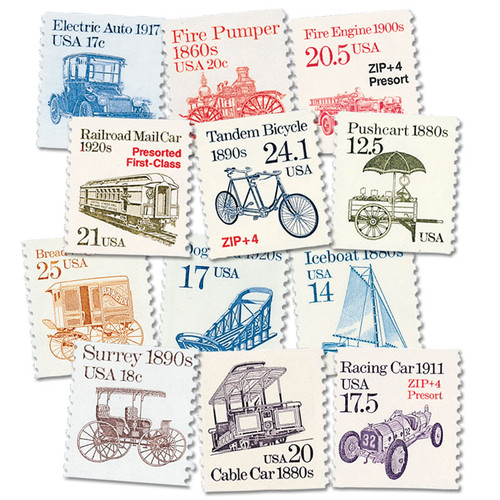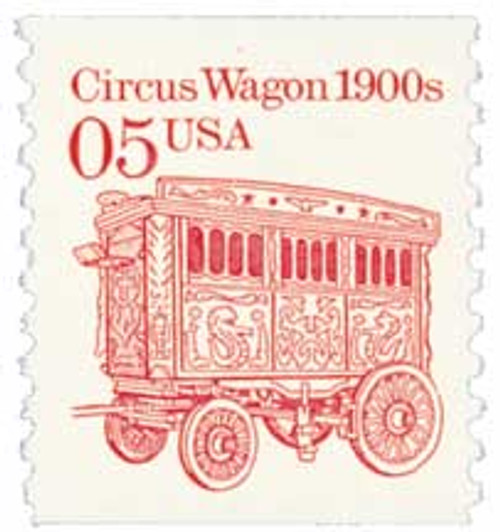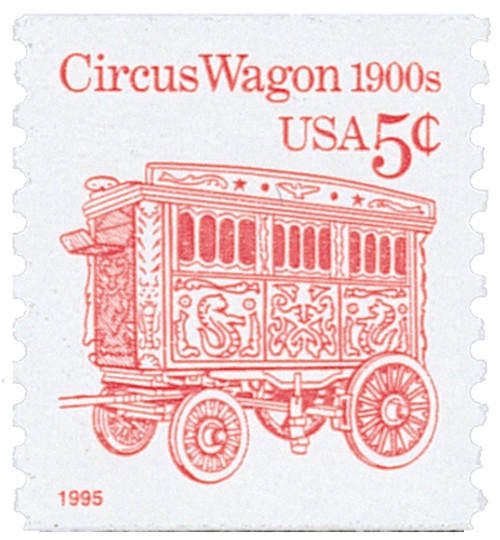
# 2454 FDC - 1991 5c Transportation Series: Canoe, 1800s, red
US #2454
1991 Canoe
- Part of the Transportation Series
- Design was previously printed by Bureau of Engraving and Printing with brown canoe
- For use by non-profit bulk mailers
Category of Stamp: Definitive
Set: Transportation Series
Value: 5¢
First Day of Issue: October 22, 1991
First Day City: Secaucus, New Jersey
Quantity Issued: 120,000,000
Printed by: Stamp Venturers
Printing Method: Photogravure
Format: Coils of10,000, from printing cylinders of 896 subjects (12 across, 33 down)
Perforations: 9.8
Color: Red, black
Reason the stamp was issued: This stamp was issued for use by non-profit bulk mailers.
About the stamp design: The canoe stamp was designed by Paul Calle. Though this was his first stamp in the Transportation series, he was a veteran stamp artist. He had researched birchbark canoes for a series of prints he had made highlighting the fur trade in the northern US and in Canada. Calle created a pencil sketch of the canoe.
This design had previously been issued in May 1991. The canoe on that stamp was brown, rather than red. It was produced by the Bureau of Engraving and Printing.
First Day City: There was no official First Day of Issue ceremony, but first-day postmarks were from Secaucus, New Jersey, the site of the issue of the earlier Canoe stamp.
About the Transportation Series: On May 18, 1981, the USPS issued the first stamp in the Transportation Series, US #1907, picturing the Surrey, a doorless four-wheeled carriage. For the first time in US history, a coil stamp featured its own unique design rather than simply copying that of the current definitive stamp. Over 50 more coil stamps would be issued over the course of the next 15 years, each picturing a different mode of transportation. All of these types of transportation were used since American independence.
The various denominations provided face values to exactly match the rates for several categories of Third-Class mail (bulk rate and quantity-discounted mail). As the rates changed, new stamps with new values were added. Never before had a stamp series included so many fractional cent values.
The Bureau of Engraving and Printing printed most of the stamps in the Transportation Series, although private contractors printed a few. All but a few of the later stamps were produced by engraved intaglio. Differences in precancels, tagging, paper and gum provide a large number of varieties.
Scott Catalog separates the Transportation stamps into four groups. The stamps in the first group (#1897-1908) generally have the denomination in small type with a “c” next to it. These stamps were printed on the Cottrell rotary press, which joined together two plates to make a sleeve. The gaps between these plates created depressions where ink would collect and create joint lines on the stamps. Later issues were printed on a different press and didn’t have these joint lines.
The second group (#2123-36) had larger numbers with no “c.” The third group (#2252-66) was similar in appearance to the second group, but service inscriptions were added to the designs. These stamps also used a variety of paper and gum as well as different types of tagging. The fourth group (#2451-68) marked the end of fractional values. Now bulk mailers would use either the 5¢ or 10¢ stamp and then pay the difference from the actual postage rate.
The last stamp in the Transportation Series, the 20¢ Cog Railway, was issued on June 9, 1995, at the TEXPEX ’95 stamp show in Dallas, Texas. This marked the end of the largest US definitive series up to that time. Three new series would eventually replace it – American Transportation, American Culture, and American Scenes. Additionally, the Great Americans would go on to become the largest American definitive series.
History the stamp represents: In the early 1700s, French fur traders learned from the Algonkin Indians how to build canoes using birch bark. These large, lightweight boats became a vital part of the fur trading industry and were used for almost 200 years by trappers, traders, and guides of the wild North American "Up Country."
US #2454
1991 Canoe
- Part of the Transportation Series
- Design was previously printed by Bureau of Engraving and Printing with brown canoe
- For use by non-profit bulk mailers
Category of Stamp: Definitive
Set: Transportation Series
Value: 5¢
First Day of Issue: October 22, 1991
First Day City: Secaucus, New Jersey
Quantity Issued: 120,000,000
Printed by: Stamp Venturers
Printing Method: Photogravure
Format: Coils of10,000, from printing cylinders of 896 subjects (12 across, 33 down)
Perforations: 9.8
Color: Red, black
Reason the stamp was issued: This stamp was issued for use by non-profit bulk mailers.
About the stamp design: The canoe stamp was designed by Paul Calle. Though this was his first stamp in the Transportation series, he was a veteran stamp artist. He had researched birchbark canoes for a series of prints he had made highlighting the fur trade in the northern US and in Canada. Calle created a pencil sketch of the canoe.
This design had previously been issued in May 1991. The canoe on that stamp was brown, rather than red. It was produced by the Bureau of Engraving and Printing.
First Day City: There was no official First Day of Issue ceremony, but first-day postmarks were from Secaucus, New Jersey, the site of the issue of the earlier Canoe stamp.
About the Transportation Series: On May 18, 1981, the USPS issued the first stamp in the Transportation Series, US #1907, picturing the Surrey, a doorless four-wheeled carriage. For the first time in US history, a coil stamp featured its own unique design rather than simply copying that of the current definitive stamp. Over 50 more coil stamps would be issued over the course of the next 15 years, each picturing a different mode of transportation. All of these types of transportation were used since American independence.
The various denominations provided face values to exactly match the rates for several categories of Third-Class mail (bulk rate and quantity-discounted mail). As the rates changed, new stamps with new values were added. Never before had a stamp series included so many fractional cent values.
The Bureau of Engraving and Printing printed most of the stamps in the Transportation Series, although private contractors printed a few. All but a few of the later stamps were produced by engraved intaglio. Differences in precancels, tagging, paper and gum provide a large number of varieties.
Scott Catalog separates the Transportation stamps into four groups. The stamps in the first group (#1897-1908) generally have the denomination in small type with a “c” next to it. These stamps were printed on the Cottrell rotary press, which joined together two plates to make a sleeve. The gaps between these plates created depressions where ink would collect and create joint lines on the stamps. Later issues were printed on a different press and didn’t have these joint lines.
The second group (#2123-36) had larger numbers with no “c.” The third group (#2252-66) was similar in appearance to the second group, but service inscriptions were added to the designs. These stamps also used a variety of paper and gum as well as different types of tagging. The fourth group (#2451-68) marked the end of fractional values. Now bulk mailers would use either the 5¢ or 10¢ stamp and then pay the difference from the actual postage rate.
The last stamp in the Transportation Series, the 20¢ Cog Railway, was issued on June 9, 1995, at the TEXPEX ’95 stamp show in Dallas, Texas. This marked the end of the largest US definitive series up to that time. Three new series would eventually replace it – American Transportation, American Culture, and American Scenes. Additionally, the Great Americans would go on to become the largest American definitive series.
History the stamp represents: In the early 1700s, French fur traders learned from the Algonkin Indians how to build canoes using birch bark. These large, lightweight boats became a vital part of the fur trading industry and were used for almost 200 years by trappers, traders, and guides of the wild North American "Up Country."















